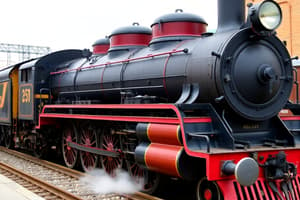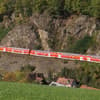Podcast
Questions and Answers
What was a primary reason for the development of railways in the early 19th century?
What was a primary reason for the development of railways in the early 19th century?
- To ensure faster and more efficient transportation of goods and people (correct)
- To replace road transport completely
- To promote tourism in isolated areas
- To connect airports with the main cities
Which component of a railway system is responsible for generating the force necessary for movement?
Which component of a railway system is responsible for generating the force necessary for movement?
- Track
- Rolling Stock
- Locomotives/Engines (correct)
- Stations and Yards
What does the term 'rolling stock' refer to in a railway system?
What does the term 'rolling stock' refer to in a railway system?
- The signaling systems used
- The tracks used by trains
- Passenger coaches and freight cars (correct)
- Locomotives and their engines
What is the primary purpose of signaling systems in a railway network?
What is the primary purpose of signaling systems in a railway network?
What significant impact did the development of railways have on communities?
What significant impact did the development of railways have on communities?
Which of the following is NOT a component of a railway system?
Which of the following is NOT a component of a railway system?
What challenges are typically involved in constructing railway lines?
What challenges are typically involved in constructing railway lines?
Why is regular maintenance crucial for a railway system?
Why is regular maintenance crucial for a railway system?
What is the primary purpose of freight railways?
What is the primary purpose of freight railways?
Which aspect is NOT covered by safety regulations in railways?
Which aspect is NOT covered by safety regulations in railways?
What is a key feature of combined railways?
What is a key feature of combined railways?
What is the significance of monitoring systems in railway safety?
What is the significance of monitoring systems in railway safety?
Which statement regarding the economic impact of railways is accurate?
Which statement regarding the economic impact of railways is accurate?
What is a fundamental part of railway safety protocols?
What is a fundamental part of railway safety protocols?
What contributes to extensive economic ripple effects when constructing railway lines?
What contributes to extensive economic ripple effects when constructing railway lines?
What is a common function of accident investigations in railways?
What is a common function of accident investigations in railways?
Flashcards
Railway Origin
Railway Origin
Railways emerged in the early 1800s in the UK, due to the need for faster and more efficient transportation.
Steam Locomotives
Steam Locomotives
Early trains used steam engines to power movement, a major improvement in transport.
Railway Impact
Railway Impact
Development of railways boosted industry and connected communities, leading to economic growth.
Railway Track
Railway Track
The track includes rails, sleepers, and ballast for train stability and support.
Signup and view all the flashcards
Rolling Stock
Rolling Stock
This includes passenger coaches and freight cars, designed to carry cargo or passengers.
Signup and view all the flashcards
Railway Signaling
Railway Signaling
Signaling controls train movement, crucial for safety.
Signup and view all the flashcards
Railway Maintenance
Railway Maintenance
Essential upkeep for railway infrastructure (tracks, engines) for smooth and safe operation.
Signup and view all the flashcards
Railway Power Supply
Railway Power Supply
Electric or other forms of power needed for electric locomotives and systems.
Signup and view all the flashcards
Freight Railways
Freight Railways
Railways primarily used for transporting goods, focusing on logistics and efficiency for cargo.
Signup and view all the flashcards
Passenger Railways
Passenger Railways
Railways optimized for transporting passengers, prioritizing speed, comfort, and service frequency.
Signup and view all the flashcards
Combined Railways
Combined Railways
Railways that combine freight and passenger services, using the same network for both.
Signup and view all the flashcards
Safety Regulations
Safety Regulations
Strict rules and procedures to minimize railway accidents and ensure passenger and worker safety.
Signup and view all the flashcards
Maintenance Schedules
Maintenance Schedules
Regular inspections and maintenance of railway equipment and infrastructure to prevent accidents.
Signup and view all the flashcards
Monitoring Systems
Monitoring Systems
Systems using technology to constantly monitor train movements, track conditions, and operations.
Signup and view all the flashcards
Economic Growth (Railways)
Economic Growth (Railways)
The role railways play in boosting economic growth through trade, accessibility and industry.
Signup and view all the flashcards
Railway Safety
Railway Safety
System-wide measures focused on minimizing accidents, ensuring safety for passengers and workers.
Signup and view all the flashcardsStudy Notes
History of Railways
- Railways originated in the early 19th century, primarily in the United Kingdom, driven by the need for faster and more efficient transportation of goods and people.
- Early railways utilized steam locomotives, which marked a significant advancement in transportation technology.
- The development of railways spurred industrial growth and connected previously isolated communities, thus contributing to economic expansion.
- Gradually, railways expanded globally, with different countries adapting and developing their own railway networks.
- The construction of railway lines often involved significant engineering challenges and required substantial investment.
Components of a Railway System
- Track: The track consists of rails, sleepers (ties), ballast, and other components for supporting the weight of trains and ensuring stability. Rail types and designs vary depending on the specific application and intended usage.
- Locomotives/Engines: Powering the train, these are crucial components capable of generating the force necessary for movement. The type of locomotive (steam, diesel, electric) significantly influences operation and maintenance requirements.
- Rolling Stock: This includes passenger coaches and freight cars, designed to carry people and goods. Their construction materials and configuration are adapted to handle varying loads, velocities, and passenger/cargo needs.
- Signaling Systems: Essential for safe and efficient operation, signaling systems control train movements and communicate information to drivers. These systems have evolved significantly to improve safety standards and accommodate higher train speeds.
- Stations and Yards: Facilities like stations (for passengers) and yards (for freight handling) are integral to a railway system. Their size and complexity depend on the volume of traffic handled.
- Power Supply: Electricity or other sources are required to power electric locomotives and signaling systems. Substations and power distribution networks are vital components.
- Maintenance: Regular maintenance is essential for the functionality and safety of railway infrastructure and rolling stock. Maintenance procedures address technical issues with locomotives, track, signalling, and other components, ensuring their reliable operation.
Types of Railways
- Freight Railways: Primarily used for transporting goods, these railways are often more focused on optimizing logistics and efficiency for cargo handling, and routes are often strategically planned for optimal loading/unloading locations and transport times.
- Passenger Railways: Optimized for transporting passengers, passenger railways concentrate on speed, comfort, and frequency of service, and usually include extensive station network provisions to accommodate passengers.
- Combined Railways: These systems combine freight and passenger services, utilizing a single network to facilitate both operations, potentially requiring balancing the differing needs of freight and passenger services.
Railway Safety and Regulation
- Safety Regulations: Strict safety regulations and protocols are essential to minimize accidents and ensure the well-being of passengers and workers. These regulations cover aspects like train operation, track maintenance, and signaling systems, as well as safety aspects for maintenance and station operations.
- Maintenance Schedules: Regular inspection and maintenance of equipment and infrastructure is a fundamental part of railway safety protocols. Schedules and procedures are designed to prevent accidents and maintain the operational integrity of systems.
- Monitoring Systems: Safety monitoring systems use a range of technologies to constantly monitor train movements, track conditions, and operational integrity. These systems utilize sensors, detectors, and other technical provisions for safety.
- Accident Investigations: Procedures for investigating accidents are critical to identifying contributing factors and implementing improvements and preventive measures. These procedures are typically established and strictly adhered to.
Economic Impacts of Railways
- Economic Growth: Railways have historically played a vital role in stimulating economic growth by facilitating trade, increasing accessibility, and supporting industrial development within regions or countries.
- Job Creation: The development or expansion of railway networks has frequently stimulated employment throughout the related infrastructure and service sectors.
- Infrastructure Development: The physical construction of railway lines necessitates broader infrastructure development encompassing bridges, tunnels, and other associated structures. This has extensive economic ripple effects.
- Trade and Logistics: Railways serve as vital transport links, facilitating the exchange of goods and services across regions and countries. Efficient railway networks are crucial for global trade and logistical operations.
Modern Trends and Challenges
- Electrification: Transitioning to electric locomotives and complete electrification of systems has reduced emissions and improved operational efficiency.
- Automation and Digitalization: Automation and digital systems enhance the efficiency and safety of rail operations, reducing labour requirements in areas like signaling and maintenance.
- Sustainability: Modern railway systems are increasingly emphasizing sustainable practices, such as using renewable energy sources and implementing environmentally friendly technologies, to counter environmental impacts.
- Urban Rail Systems: Modernizing existing and developing new urban rail systems, especially in heavily populated urban areas, continues to be a priority area considering population and traffic density concerns.
- Competition and Deregulation: Competition in the railway sector has increased, and deregulation often aims to promote efficiency.
Studying That Suits You
Use AI to generate personalized quizzes and flashcards to suit your learning preferences.





